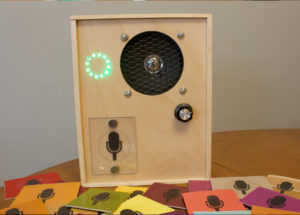colors

creative
technology
Ken Nordine is often associated with the Beats of the 1960’s and invented an art form called Word-Jazz. I find his jazz-backed stories mesmerizing. He recorded an entire album – 34 tracks – called Colors with invented stories, each revolving around a single color.
The fact that the genesis of the album was a commission from a paint company does not diminish my appreciation of it. Each track is unpredictable and spins a tale as only Nordine can.
I wanted to build a project that would present these tracks to a modern audience. Tap a color on a screen to hear a story about that color? Boring. Not only that but how much thought would people put into their color selection if all they did was tap adjacent boxes?
I considered many options for the look of the device and the interface before finally deciding on a wooden box that looks more or less like a radio with a speaker and volume control but no outward signs of how to play a track. Accompanying the box are 34 “color chips”, made of colored card stock taped together, in the colors of each track.
As a prompt each color chip sports a sticker with an image of a microphone. Attached to the wooden box is a piece of Lexan with an identical sticker on it. Holding the color chip up to the microphone icon magically makes the track corresponding to the color chip begin to play. Along with the sound, a circle of LED lights animates for the duration of the track.
I would argue that the physical interface is more successful than a screen interface would be. People choose with care which chip they pick up and, along with the anticipation of what Nordine has in store for them it’s also not always apparent which color they picked up when the options include such colors as Chartreuse, Puce and Hazel., so it’s fun to guess which one you selected.
Initial prototyping for this project was a bit painful. I originally wanted to use a color sensor to read the color directly from the color chips. I knew before starting there would be trouble trying to distinguished between red, crimson and maroon. The inconsistencies of readings, though, made it impossible even to tell non-similar colors from each other.
After many hours of working with two types of color sensors I gave up and moved on with RFID. From my perspective it would be really slick to know that colors were being read right off the chip. To anyone else, I realize, it is the same experience if they hold up a color chip with an embedded RFID tag and a track begins to play.
The breadboard prototypes used an Arduino Uno with an Adafruit Wave Shield. The built device uses an Arduino Pro Mini and a tiny BY8001-16P audio player. Besides being physically small the player does not need the bulky wav library the shield requires and the sound quality is plenty good enough for this project.
LED animations play on a ring of NeoPixels by Adafruit. I wrote a class that plays one of a number of animations for a period of time then selects a another animation to play at random. The main code only needs to tell the animation class to begin when a track is played and end when playback is complete. I learned early on the NeoPixels need to have their own power source or they will interfere with the audio.
The code is available on GitHub.